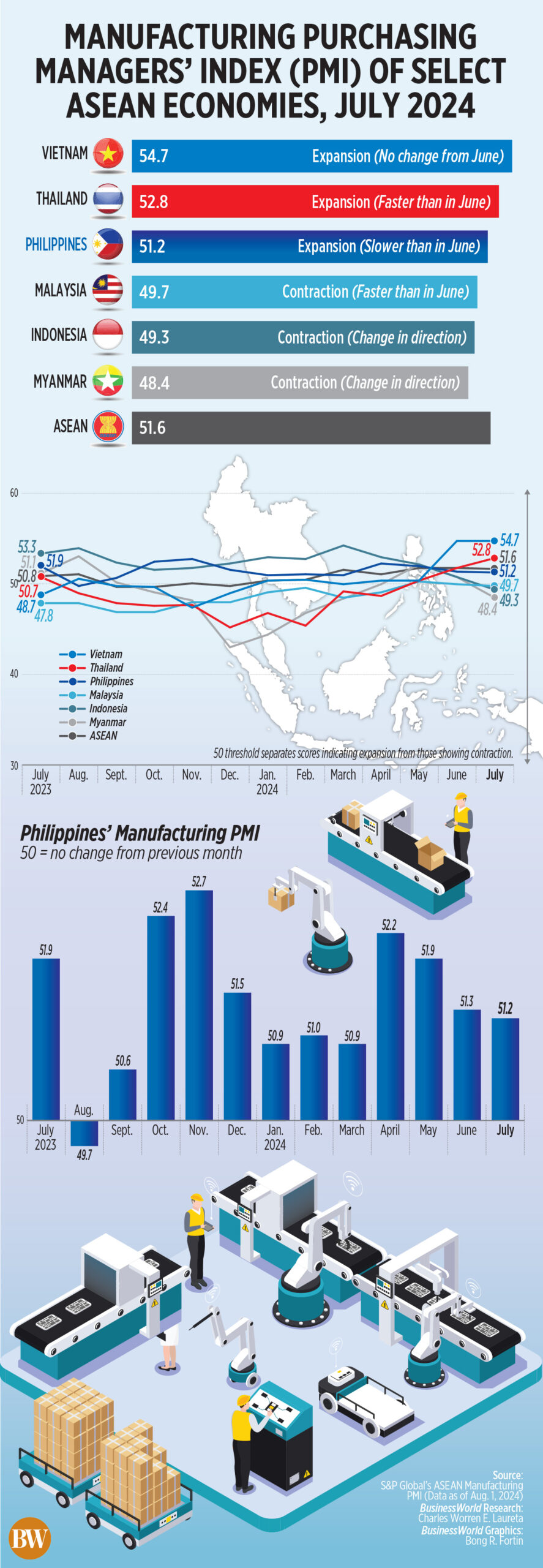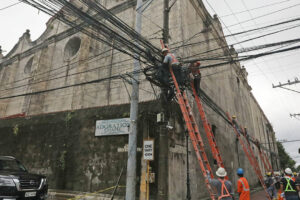Business
Industrial growth slows slightly in July

Production growth slowed slightly in July, in the midst of the economic crisis weaker expansion of production and orders, S&P Global said Thursday.
The S&P Global Philippines Manufacturing Purchasing Managers’ Index (PMI) stood at 51.2 in July, down from 51.3 in June.
“The latest index reading indicated only a modest improvement in the health of the Philippine manufacturing sector, and an improvement that was the weakest since March (when the PMI stood at 50.9),” the report said.
July also marked the 11e month of improvement in business conditions. A PMI reading above 50 indicates an improvement in business conditions, while a reading below 50 means the opposite.
Among Association of Southeast Asian Nations (ASEAN) member states with available data, the Philippines had the third highest score in July, behind Vietnam (54.7) and Thailand (52.8). Malaysia (49.7), Indonesia (49.3) and Myanmar (48.4) all recorded contractions.
The Philippine PMI was also lower than the ASEAN average of 51.6 in July.
“The second half of the year started modestly, with the Philippine manufacturing sector signaling further production increases and new orders,” Maryam Baluch, economist at S&P Global Market Intelligence, said in a report.
“Although in both cases, the rates of increase were weaker than their respective long-term averages, indicating relatively moderate growth across the sector.”
S&P Global said the latest data shows manufacturing activity grew at the slowest pace over the past four months due to longer delivery times from suppliers.
“The number of delays was the most pronounced since February as congestion at ports hampered the timely delivery of inputs,” the report said.
On the other hand, demand improved in the Philippine manufacturing sector.
“New orders rose faster than the low point in the past five months. However, companies recorded modest and cooling demand from overseas markets,” S&P Global said.
Nevertheless, a continued increase in production needs allowed manufacturers to boost their purchasing activities in July.
“Although the pace of growth has weakened since the previous survey period, it has been solid overall. Companies remained eager to expand their inventories of finished goods and purchased items. Both pre- and post-production inventories accumulated at rates that were stronger than their respective long-term averages,” S&P Global said.
Even though the deficit decreased for the 13e For a month in a row, manufacturing companies increased their workforces in July after seeing a “strong increase” in new orders. S&P said this was the first increase in employment since April, although it was still “modest” overall.
The July figures show that costs rose slightly in July, even as input price inflation rose to a five-month high. On the other hand, the pace of cost growth fell to the lowest level in three months.
The eFThe impact of Super Typhoon Carina was likely to have caused disruptions in manufacturing and other business activities in Metro Manila and nearby provinces, said Rizal Commercial Banking Corp. Chief Economist Michael L. Ricafort.
Last week, Metro Manila and nearby provinces experienced heavy and heavy rainfall Fflooding caused by Carina (international name: Gaemi) and the southwest monsoon.
OUTLOOK
Meanwhile, Ms. Baluch said declining inflation, as shown in the PMI data, could allow the Philippine central bank to start cutting interest rates.
“Easing financial conditions should help consolidate and strengthen growth in the coming months,” she noted.
“In addition, continued expansions in purchasing activities and renewed workforce increases indicate that goods manufacturers are likely to expect a strengthening of demand conditions in the coming months.”
The Monetary Board has kept its key policy rate at a 17-year high of 6.5% to keep inflation under control. Bangko Sentral ng Pilipinas Governor Eli M. Remolona Jr. signaled a possible interest rate cut during their August 15 meeting.
Mr Ricafort said slower PMI growth could “help support/justify” a 25 basis point rate cut as early as next week.
S&P Global said manufacturing companies expect production to increase over the next 12 months.
“The Future Output Index, which traded comfortably above neutral 50 in July, indicated optimism about the prospects for the sector,” the report said.
However, there was a slight decline in confidence as some companies remained cautious about future demand.
Robert Dan J. Roces, chief economist at Security Bank Corp., noted that manufacturing companies’ cautious optimism is reflected in their hiring activities and inventory accumulation.
“While risks such as global economic conditions and supply chain disruptions remain, the overall outlook for Philippine manufacturing remains positive, with growth expected to continue in the coming months, albeit at a modest pace,” he said in a Viber -message.
Mr Ricafort said there has been a seasonal increase in imports and production in the third quarter, in preparation for higher demand in the fourth quarter.
“This would help boost output growth in the coming months,” he said, although business activity could slow during the “ghost month” of August. — Beatriz Marie D. Cruz









